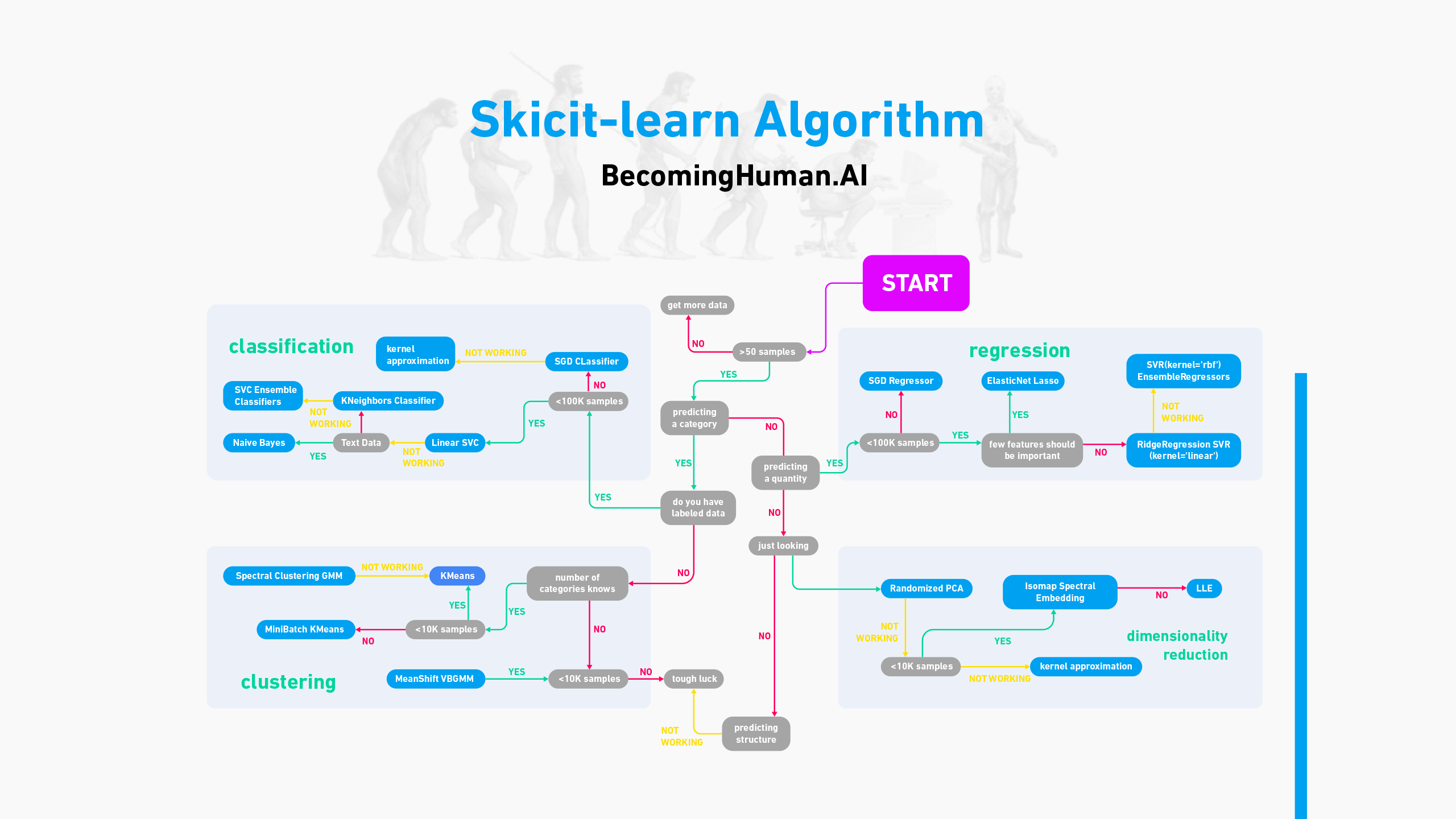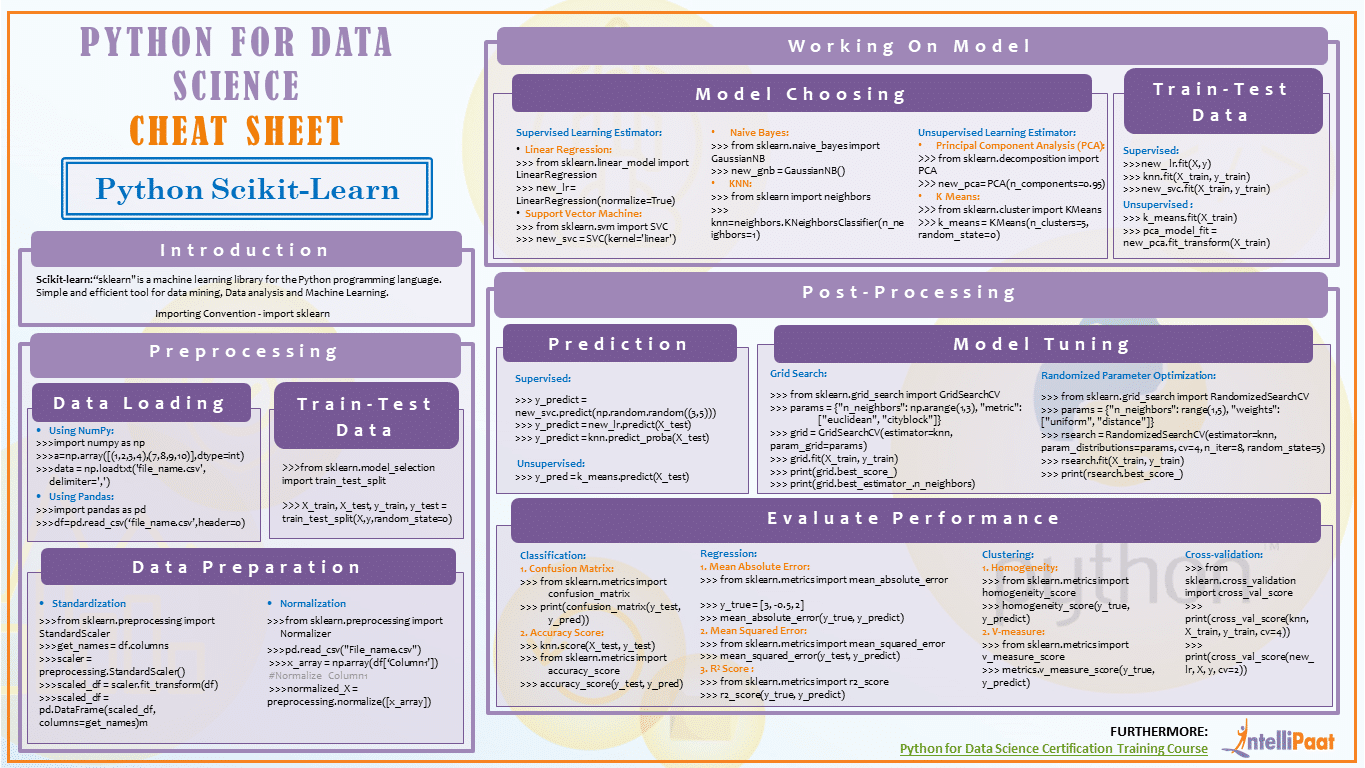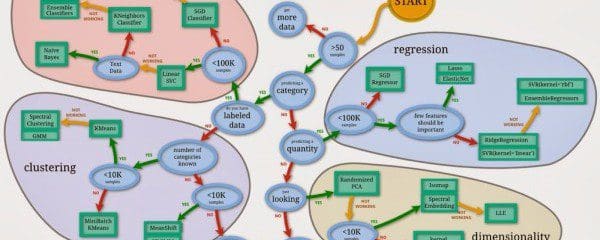Machine Learning: Scikit-learn algorithm The machine learning cheat sheet helps you get the right estimator for the job which is the most challenging part. The flowchart helps you check the documentation and rough guide of each estimator which assists you to discover more information about related problems and their ultimate solutions.
- Scikit Learn Cheat Sheet Pdf
- Scikit Algorithm Cheat Sheet
- Scikit-learn Algorithm Cheat Sheet
- Python Algorithm Cheat Sheet
- Machine Learning: Scikit-learn algorithm This machine learning cheat sheet will help you find the right estimator for the job which is the most difficult part. The flowchart will help you check the documentation and rough guide of each estimator that will help you to know more about the problems and how to solve it.
- Cheatsheets for Numpy, Pandas, Matplotlib, Scipy, Scikit Learn, ggplot2, TensorFlow, Neural Networks, Keras, Deep Learning - DipakMajhi/Machine-Learning-CheatSheets.
Complete List of Cheat Sheets and Infographics for Artificial intelligence (AI), Neural Networks, Machine Learning, Deep Learning and Big Data.
Content Summary
Neural Networks
Neural Networks Graphs
Machine Learning Overview
Machine Learning: Scikit-learn algorithm
Scikit-Learn
Machine Learning: Algorithm Cheat Sheet
Python for Data Science
TensorFlow
Keras
Numpy
Pandas
Data Wrangling
Data Wrangling with dplyr and tidyr
Scipy
Matplotlib
Data Visualization
PySpark
Big-O
Resources
Neural Networks
Scikit Learn Cheat Sheet Pdf
Artificial neural networks (ANN) or connectionist systems are computing systems vaguely inspired by the biological neural networks that constitute animal brains. The neural network itself is not an algorithm, but rather a framework for many different machine learning algorithms to work together and process complex data inputs. Such systems “learn” to perform tasks by considering examples, generally without being programmed with any task-specific rules.
Neural Networks Graphs
Graph Neural Networks (GNNs) for representation learning of graphs broadly follow a neighborhood aggregation framework, where the representation vector of a node is computed by recursively aggregating and transforming feature vectors of its neighboring nodes. Many GNN variants have been proposed and have achieved state-of-the-art results on both node and graph classification tasks.
Machine Learning Overview
Machine learning (ML) is the scientific study of algorithms and statistical models that computer systems use to progressively improve their performance on a specific task. Machine learning algorithms build a mathematical model of sample data, known as “training data”, in order to make predictions or decisions without being explicitly programmed to perform the task. Machine learning algorithms are used in the applications of email filtering, detection of network intruders, and computer vision, where it is infeasible to develop an algorithm of specific instructions for performing the task.
Machine Learning: Scikit-learn algorithm
This machine learning cheat sheet will help you find the right estimator for the job which is the most difficult part. The flowchart will help you check the documentation and rough guide of each estimator that will help you to know more about the problems and how to solve it.
Scikit-Learn
Scikit-learn (formerly scikits.learn) is a free software machine learning library for the Python programming language. It features various classification, regression and clustering algorithms including support vector machines, random forests, gradient boosting, k-means and DBSCAN, and is designed to interoperate with the Python numerical and scientific libraries NumPy and SciPy.
Machine Learning: Algorithm Cheat Sheet

This machine learning cheat sheet from Microsoft Azure will help you choose the appropriate machine learning algorithms for your predictive analytics solution. First, the cheat sheet will asks you about the data nature and then suggests the best algorithm for the job.
Python for Data Science
TensorFlow
In May 2017 Google announced the second-generation of the TPU, as well as the availability of the TPUs in Google Compute Engine. The second-generation TPUs deliver up to 180 teraflops of performance, and when organized into clusters of 64 TPUs provide up to 11.5 petaflops.
Keras
In 2017, Google’s TensorFlow team decided to support Keras in TensorFlow’s core library. Chollet explained that Keras was conceived to be an interface rather than an end-to-end machine-learning framework. It presents a higher-level, more intuitive set of abstractions that make it easy to configure neural networks regardless of the backend scientific computing library.
Numpy
NumPy targets the CPython reference implementation of Python, which is a non-optimizing bytecode interpreter. Mathematical algorithms written for this version of Python often run much slower than compiled equivalents. NumPy address the slowness problem partly by providing multidimensional arrays and functions and operators that operate efficiently on arrays, requiring rewriting some code, mostly inner loops using NumPy.
Pandas
The name ‘Pandas’ is derived from the term “panel data”, an econometrics term for multidimensional structured data sets.
Data Wrangling
The term “data wrangler” is starting to infiltrate pop culture. In the 2017 movie Kong: Skull Island, one of the characters, played by actor Marc Evan Jackson is introduced as “Steve Woodward, our data wrangler”.
Data Wrangling with dplyr and tidyr
Scipy
Scikit Algorithm Cheat Sheet
SciPy builds on the NumPy array object and is part of the NumPy stack which includes tools like Matplotlib, pandas and SymPy, and an expanding set of scientific computing libraries. This NumPy stack has similar users to other applications such as MATLAB, GNU Octave, and Scilab. The NumPy stack is also sometimes referred to as the SciPy stack.
Matplotlib

matplotlib is a plotting library for the Python programming language and its numerical mathematics extension NumPy. It provides an object-oriented API for embedding plots into applications using general-purpose GUI toolkits like Tkinter, wxPython, Qt, or GTK+. There is also a procedural “pylab” interface based on a state machine (like OpenGL), designed to closely resemble that of MATLAB, though its use is discouraged. SciPy makes use of matplotlib. pyplot is a matplotlib module which provides a MATLAB-like interface. matplotlib is designed to be as usable as MATLAB, with the ability to use Python, with the advantage that it is free.
Data Visualization
PySpark

Big-O
Big O notation is a mathematical notation that describes the limiting behavior of a function when the argument tends towards a particular value or infinity. It is a member of a family of notations invented by Paul Bachmann, Edmund Landau and others, collectively called Bachmann–Landau notation or asymptotic notation. Java markdown to html free.
Resources
Big-O Algorithm Cheat Sheet
Bokeh Cheat Sheet
Data Science Cheat Sheet
Data Wrangling Cheat Sheet
Data Wrangling
Ggplot Cheat Sheet
Keras Cheat Sheet
Keras
Machine Learning Cheat Sheet
Machine Learning Cheat Sheet
ML Cheat Sheet
Matplotlib Cheat Sheet
Matpotlib
Neural Networks Cheat Sheet
Neural Networks Graph Cheat Sheet
Neural Networks
Numpy Cheat Sheet
NumPy
Pandas Cheat Sheet
Pandas
Pandas Cheat Sheet
Pyspark Cheat Sheet
Scikit Cheat Sheet
Scikit-learn
Scikit-learn Cheat Sheet
Scipy Cheat Sheet
SciPy
TesorFlow Cheat Sheet
Tensor Flow
Course Duck > The World’s Best Machine Learning Courses & Tutorials in 2020
Tag: Machine Learning, Deep Learning, Artificial Intelligence, Neural Networks, Big Data
Related posts:
Hey Finxters! Do you know what time it is? That’s right! It’s time for some more cheat sheets!! These cheat sheets are meant to help you on your way to becoming a great Python developer and of course becoming one of the best Python freelancers globally! This article is all about algorithms used in software development and the cheat sheets we will use to do this. Let’s get started without further delay!
Cheat Sheet 1: Princeton
This cheat sheet is one you will want to bookmark as it is part of an ebook! It primarily focuses on Algorithm and Data Structures.The area I would like you to focus is ⅓ of the way down beginning at arrays. Consider bookmarking the book(I have!) Chapter 4 deep dives into algorithms and data structures. It includes a list of the Python code structures used throughout the chapter with complete explanations on what is happening and the how!
Pros: Perfect for deep diving into Algorithm coding in Python!
Cons: Part of an ebook

Cheat Sheet 2: AlgoDaily.com
This cheat sheet will go over the concepts of Big-O and Algorithmic complexity used in programming. Plus a video that discusses the concept! Algodaily is the place to be if you want to learn Algorithms and data structures for interviews to land a software career as a consultant or full time employee for a company.
Pros: Best place to learn everything you need to know for Algorithms and Data structures!
Cons: Does not have the ability to print, more structured towards interviews.
Cheat Sheet 3: Microsoft
This cheat sheet can be downloaded and pinned to the wall behind the monitor or place in your developers binder. It is carefully structured by microsoft to show you how to properly use algorithms for ML. Start in the What do you want to do box and you will be on your way to writing your algorithm!
Pros: Perfect place to start. It answers the question Where do I start?
Cons: None that I can see.
Cheat Sheet 4: Cheatography
This cheat sheet is all about sorting algorithms with boiler code included for bubble sorting, quicksort and selection. It presents a clear table of which is a method and which is a sorting algorithm. Print this one and keep it pinned to the wall or place it in your developers binder
Pros: Rated ‘E’ for everyone.
Cons: None that I can see.
Scikit-learn Algorithm Cheat Sheet
Cheat Sheet 5: Medium
This cheat sheet is for learning the searching and sorting algorithms used in Python. It has code snippets, visuals on the different algorithms and explanations. This cheat sheet is on Medium, a fast up-coming developers source on information in the Development and IT field. Bookmark this page, since it doesn’t print.

Pros: Great place to begin learning sorting and searching algorithms.
Cons: You’ll have to subscribe to Medium to read this cheat sheet.
Cheat Sheet 6: Dummies
Here is another cheat sheet for you to bookmark, presented to you from the classic series How to for Dummies. It has tables for looking for, which has type, explanations and links for further explanations.
Pros: Perfect if you’re having a hard time understanding where to begin with your algorithms
Cons: Cannot be printed. Bookmark the page, I did.
Cheat Sheet 7: Packt
This is a pdf that you can print and pin to the wall behind the monitor! It has tables of the different algorithms, the data structures and graphs. Keep it handy when you are learning Big-O algorithms.
Pros: Rated ‘E’ for everyone.
Cons: You’ll have to go to Packt for the Big-O book to read.
Cheat Sheet 8: Analytics Vidhya
This cheat sheet is broken down into 2 sides with Python and R for machine learning algorithms for supervised, unsupervised and reinforcement learning. It has code examples to get you started for both languages.
Pros: Rated ‘E’ for everyone, contains 2 languages.
Cons: Save it as an image to your laptop before printing.
Cheat Sheet 9: Scikit Learn
This cheat sheet map uses Scikit Learn to point you towards the right estimator to try on your data sets.
Pros: Rated ‘E’ for everyone.
Cons: No code samples.
Cheat Sheet 10: SAS
This cheat sheet is used to help point you towards the correct algorithm to use for your data sets. The tutorial found online. Which machine learning algorithm do I use will help you make the correct choice.
Pros: Rated ‘E’ for everyone. How to transfer contacts from gmail to iphone 6s.
Cons: None that I can see.
This is just some of the cheat sheets I have found online and there are a ton more!! It is important to really understand Machine learning algorithms so I encourage you to sign up for a library (Packt is great!) and read the books they have available! To get you started I added a book from Pearsons! This book is an Introduction to Programming with Python! It covers Python from its basics to the algorithms and data structures you need to get you started! Keep on becoming a great Pythoner! One code at a time!
Related Articles:
While working as a researcher in distributed systems, Dr. Christian Mayer found his love for teaching computer science students.
To help students reach higher levels of Python success, he founded the programming education website Finxter.com. He’s author of the popular programming book Python One-Liners (NoStarch 2020), coauthor of the Coffee Break Python series of self-published books, computer science enthusiast, freelancer, and owner of one of the top 10 largest Python blogs worldwide.
His passions are writing, reading, and coding. But his greatest passion is to serve aspiring coders through Finxter and help them to boost their skills. You can join his free email academy here.
Python Algorithm Cheat Sheet
Related Posts
